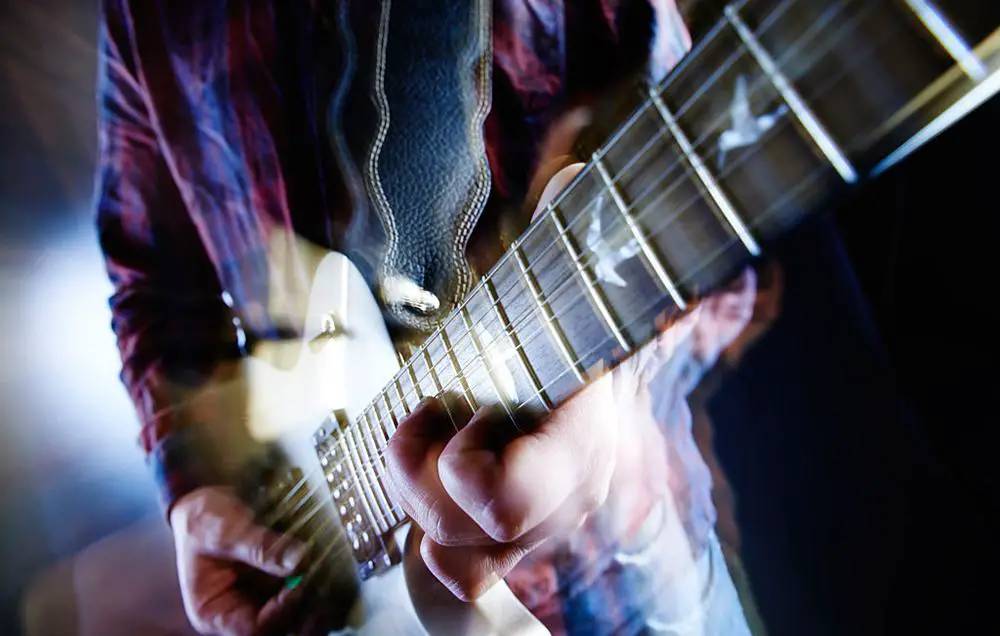Have you ever found yourself shredding an epic guitar solo only to realize you have no idea what you’re doing? Fear not, my fellow axe-wielders, for we are about to embark on a journey through the wild and wicked world of music theory. Get ready to unlock the secrets behind those blistering licks and face-melting riffs as we dive headfirst into the realm of mastering guitar solos with a healthy dose of humor and a whole lot of know-how. So grab your six-string, strap in tight, and prepare to rock your way to solo stardom!
Contents
- 1 Understanding the Building Blocks of Music Theory for Guitar Solos
- 2 Exploring Scales and Modes: The Foundation of Melodic Solos
- 3 Harmony and Chord Progressions: Crafting the Perfect Backdrop for Your Solos
- 4 Utilizing Arpeggios and Chord Tones for Expressive Solos
- 5 Incorporating Dynamics and Articulation to Elevate Your Guitar Solos
- 6 Navigating Through Improvisation with Theoretical Knowledge
- 7 Mastering the Art of Emotional Expression through Advanced Theoretical Concepts
- 8 FAQs
- 9 Rock On!
Understanding the Building Blocks of Music Theory for Guitar Solos
So you’ve mastered the basic chords and scales on your guitar and are ready to take your skills to the next level with some killer solos. But before you start shredding like a rock god, it’s important to have a solid understanding of the building blocks of music theory that will help you create mind-blowing guitar solos. Don’t worry, we’ve got you covered!
First off, let’s talk about intervals. This is basically the distance between two pitches, and understanding them is crucial for creating melodic and harmonic interest in your solos. Experiment with different intervals to see how they affect the mood and feel of your solo.
Next, let’s dive into scales. These are the foundation of any good guitar solo, so make sure you know your major, minor, and pentatonic scales like the back of your hand. Mix and match them to create interesting and dynamic melodies that will keep your listeners on the edge of their seats.
Lastly, don’t forget about rhythm. A killer guitar solo isn’t just about playing fast – it’s also about playing with feeling and groove. Experiment with syncopation, triplets, and other rhythmic patterns to add some spice to your solos and make them truly unforgettable.

Exploring Scales and Modes: The Foundation of Melodic Solos
So you want to shred like a guitar god, huh? Well, you better start by understanding the building blocks of melodic solos – scales and modes! Don’t worry, it’s not as intimidating as it sounds. In fact, once you get the hang of it, you’ll be soloing like a pro in no time.
Let’s start with scales. These are a series of notes that follow a specific pattern and are the foundation of any melodic solo. Think of them as the ingredients in a recipe – without them, your solo will just be bland! Some popular scales to start with include:
- Major scale
- Minor scale
- Pentatonic scale
Now, onto modes. Modes are like different flavors of scales - they give your solos that extra kick! Each mode starts on a different note within a scale and has its own unique sound. Some common modes include:
- Ionian
- Dorian
- Phrygian
So there you have it – the foundation of melodic solos! Practice your scales and modes, experiment with different combinations, and soon enough, you’ll be wowing audiences with your killer solos. Remember, it’s all about having fun and expressing yourself through your music. Now go forth and rock on!

Harmony and Chord Progressions: Crafting the Perfect Backdrop for Your Solos
So you’ve got your killer guitar solo down, but something feels like it’s missing. That’s where harmony and chord progressions come in to save the day! Crafting the perfect backdrop for your solos is like painting a masterpiece – you want a harmonious blend of colors and textures to really make your solo shine.
One key to creating a killer backdrop for your solos is choosing the right chords. Don’t just stick to the basic major and minor chords – get creative! Experiment with diminished, augmented, and suspended chords to add some unique flavor to your progression. Mix and match different chord qualities to keep things interesting and unexpected.
Another important aspect to consider is the timing of your chord changes. A well-timed chord change can really elevate your solo and create tension and release in all the right places. Make sure to pay attention to the rhythm of your chord progression and use it to enhance the overall feel of your solo.
- Experiment with different voicings of the same chord to create a fuller sound.
- Try playing around with different inversions to add movement and dynamics to your progression.
- Don’t be afraid to throw in some unusual or dissonant chords for a real wow factor.

Utilizing Arpeggios and Chord Tones for Expressive Solos
So you want to take your solos to the next level, huh? Well, I’ve got just the trick for you – utilizing arpeggios and chord tones! Trust me, it’s like adding a secret ingredient to your musical stew that will have everyone begging for more.
First things first, let’s talk arpeggios. These bad boys are like the building blocks of chords, so incorporating them into your solos will instantly give them that extra oomph. Try outlining the chords in your progression with arpeggios to create a strong foundation for your soloing adventures.
Now, onto chord tones. These are the juicy bits of a chord that really make it sing. By targeting these tones in your solos, you’ll be able to create lines that not only sound smooth but also connect seamlessly with the chords underneath. Think of it as weaving a beautiful musical tapestry.
So there you have it, folks. With a sprinkle of arpeggios and a dash of chord tones, your solos will be bursting with expression and personality. So go forth, my fellow musicians, and conquer the stage with your newfound soloing prowess!

Incorporating Dynamics and Articulation to Elevate Your Guitar Solos
When it comes to guitar solos, adding dynamics and articulation is like adding sprinkles to ice cream – it just makes everything better! So how can you take your solos from basic to mind-blowing? Let’s dive in:
First things first – dynamics! Dynamics are like the volume knob of your solo. You need to play around with different levels of intensity to keep your audience on their toes. Start off soft and gentle, then build up to a roaring crescendo. Think of it like a rollercoaster ride - except you’re the one in control (for now).
Next up, articulation! This is where you get to show off your personality as a guitarist. Are you a smooth operator, gliding through notes like a hot knife through butter? Or maybe you’re more of a sharp-shooter, hitting each note with pinpoint precision. Whatever your style, articulation is the key to making your solo memorable.
And don’t forget about those bends, slides, and vibratos! These techniques are like the spice rack of your solo – they add flavor and flair that can take your playing to the next level. So get experimenting and see what works best for you. Who knows, you might just stumble upon your secret sauce!
So, you want to navigate through improvisation with some theoretical knowledge, huh? Well, strap in because we’re about to take a wild ride through the wonderful world of improv!
First things first, let’s talk about the importance of knowing your basic improv principles. You’ve got your “yes, and” rule, where you agree with your scene partner and build upon their idea. Then there’s the concept of staying in the moment and embracing the unknown. And of course, who could forget about the golden rule of making your scene partner look good? Remember, it’s all about teamwork!
Now, when it comes to incorporating theoretical knowledge into your improvisational skills, think of it like adding a sprinkle of fairy dust to your scene. It’s that extra bit of magic that can take your performance to the next level. Whether it’s using different character archetypes, exploring themes and motifs, or even playing with different narrative structures, having that theoretical foundation can really help elevate your improv game!
And let’s not forget about the element of surprise in improv. With theoretical knowledge in your back pocket, you can throw in unexpected twists and turns that will keep your scene partners on their toes. Who knows, maybe you’ll even surprise yourself with the crazy directions your scenes can take! So, go forth and conquer the world of improv with your newfound theoretical knowledge – the stage is your playground!
Mastering the Art of Emotional Expression through Advanced Theoretical Concepts
Are you tired of being emotionally constipated? Unable to fully express yourself without feeling like a social outcast? Well, fear no more! In this post, we will explore advanced theoretical concepts to help you master the art of emotional expression like never before.
First up, let’s discuss the concept of emotional granularity. This fancy term simply means being able to differentiate between different emotions instead of just lumping them all together as “good” or ”bad”. Imagine a spectrum of emotions, ranging from mildly annoyed to full-blown rage. By being able to pinpoint exactly where you fall on this spectrum, you can better communicate your feelings to others.
Next, let’s delve into the idea of emotional intelligence. This involves not only recognizing and understanding your own emotions, but also being able to empathize with others on a deeper level. Think of it as emotional multitasking – you’re not just focused on your own feelings, but also actively tuning in to the emotional signals of those around you.
And finally, we’ll touch on the concept of emotional regulation. This is like having a mental volume knob for your feelings. Instead of exploding like a volcano at the slightest provocation, you can learn to dial down the intensity of your emotions or ramp them up when needed. It’s all about finding that sweet spot where you can express yourself authentically without going overboard.
FAQs
Can music theory actually help me master guitar solos?
Absolutely! While some may think music theory is just a bunch of boring rules and formulas, it can actually provide valuable insights into how music works. Understanding scales, chords, and harmony can give you the tools you need to create killer guitar solos.
How can music theory improve my guitar soloing skills?
By understanding how different scales and chords work together, you can create more interesting and dynamic solos. You’ll be able to make more informed choices about which notes to play and when to play them, leading to solos that really stand out.
Do I have to be a music theory genius to benefit from this?
Not at all! While a deep understanding of music theory certainly won’t hurt, even a basic knowledge can go a long way. Just learning a few key scales and chords can open up a whole world of possibilities for your guitar playing.
What are some practical tips for incorporating music theory into my solos?
One great tip is to start by learning the major and minor scales, as well as some common chord progressions. Experiment with playing these scales over different chords and see what sounds good to you. You can also try adding in techniques like arpeggios and chromatic notes to spice up your solos.
Will learning music theory make me lose my creativity?
Not at all! In fact, many musicians find that a deeper understanding of music theory actually enhances their creativity. Knowing the rules allows you to break them in interesting ways, leading to more unique and innovative solos.
How can I make practicing music theory fun?
Try turning your music theory practice into a game! Challenge yourself to come up with a new solo using a specific scale or chord progression. Set small goals for yourself, like mastering a new scale or learning a new chord voicing. Remember, the more you practice, the easier and more intuitive music theory will become.
Rock On!
Congratulations, you’ve now unlocked the power of guitar solos through the magic of music theory. So go forth and shred those strings like the guitar god you were always meant to be. Remember, practice makes perfect, but a little music theory never hurt either. Keep rocking and roll those fingers across those frets!



